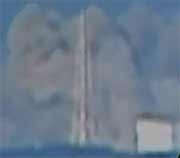
TUESDAY, March 15 (HealthDay News) — Although remnants of the tsunami that devastated the nuclear complex in Japan did manage to reach America’s shores, it’s highly unlikely that any radiation from the unfolding disaster across the Pacific Ocean will make it to North America, experts say.
The chances of any radioactive plume reaching the United States are “close to zero,” said Jacqueline Williams, program director for radiation medicine at the University of Rochester Medical Center’s Center for Biophysical Assessment and Risk Management Following Irradiation.
“Obviously, what’s happening [in Japan] is changing from moment to moment,” Williams added, “but there seems to be very little in the way to fear.”
Levels of radioactivity that have already been released in Japan “are very much dissipated, so by the time it gets to California or the U.S., it would be extremely low levels,” agreed Barry Rosenstein, a professor of radiation oncology at Mt. Sinai School of Medicine in New York City.
The reason for that, simply, is that “Japan is a long way away,” said Williams, who’s also vice president of the Radiation Research Society.
While considerable amounts of radiation have escaped from the four damaged reactors in Japan — and with experts predicting much more, perhaps soon — any of that radiation would have to travel by air to North America, more than 5,000 miles away.
During that journey, said Williams, any radioactivity in the air would be dispersed and therefore greatly weakened.
“Just the sheer dilution factor, whether by water [nuclear plant workers in Japan have been flooding the damaged reactors with seawater in an effort to cool them] or air, it’s not going to affect anyone here,” she said.
And that would probably hold true “even if they [the Japanese] had the most catastrophic event, like a Chernobyl [in 1986 in the Ukraine] and you had a large amount of radioactivity being released,” Williams added.
Also, heavier radiation particles would fall out of a radioactive plume, so “by the time anything reached us it would be no more than we experience normally,” she said. “Everyone is being irradiated all the time.”
This so-called “background” radiation isn’t harmful and comes from sources in the Earth, solar rays in the atmosphere, and even drinking water.
But it’s not inconceivable that the health risk in the United States might have to be reassessed if the Japan disaster reached catastrophic proportions, Rosenstein said.
“In harkening back to Chernobyl, where there was a tremendous release of radioactive isotopes, it did affect a good portion of Europe, certainly well beyond the Chernobyl area,” he said.
Still, he pointed out, Europe and the Ukraine are much closer to each other than are Japan and the United States, even when talking about Hawaii or Alaska.
At this point, however, there is “no concern” about harmful effects from radioactivity this side of the Pacific, Rothstein said.
The Nuclear Regulatory Commission concurs. All the available information indicates that “weather conditions have taken the small releases from the Fukushima reactors out to sea away from the population. Given the thousands of miles between the two countries, Hawaii, Alaska, the U.S. Territories and the U.S. West Coast are not expected to experience any harmful levels of radioactivity,” the agency said on its Web site.
Still, not everyone is so sanguine.
Dr. Ira Helfand, a Massachusetts-based nuclear safety expert and past-president of Physicians for Social Responsibility, told CBS News that if fuel at one of the four crippled reactors in Japan were to melt down and break through the containment vessel, it could cause a massive explosion as superheated fuel mixed with the water coolant.
“The fuel rods contain enormous amounts of radioactive material — each reactor can release more radiation than 1,000 Hiroshima-sized bombs,” Helfand told the network.
He said it’s not clear just how far radiation from such an accident would spread — and what the potential health threats might be, CBS reported.
“At Chernobyl, it spread over large areas of Europe, and significant areas up to 100 miles downwind needed to be abandoned,” he said. “But the conditions were somewhat different, and we aren’t sure how far the radiation will be distributed this time.”
Meanwhile, the crisis at Japan’s stricken complex of four nuclear reactors deteriorated dramatically Tuesday as explosions continued to rock the site and reports emerged that water in a pool used to cool spent fuel rods may be boiling.
More radiation was released from the complex that was devastated by Friday’s earthquake and resulting tsunami, and Prime Minister Naoto Kan said the radiation had leaked from the four reactors, the Associated Press reported.
To combat health risks to residents, government officials were planning to distribute potassium iodide pills to prevent thyroid cancer, the most immediate risk. However, in a worst-case scenario — large amounts of released radiation — the result could be many other types of cancers years later, the AP reported.
More information
For more on the risks of nuclear radiation, visit the University of Pittsburgh.

